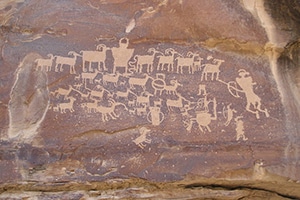Located on the northwestern edge of the Colorado Plateau in Utah, there is evidence of Native Americans dating back 8,000 years. In an area now known as Nine Mile Canyon, a Native American tribe known as the Fremont Culture made this their home as early as 300 A.D. This prehistoric culture, primarily hunters and farmers, utilized quite sophisticated methods including irrigation for farming. By 700 A.D., villages had been established and the Fremont region flourished until around 1250 A.D. It is thought that more aggressive Ute, Paiute and Shoshoni peoples that migrated to the area may have displaced the tribe or absorbed the Fremont into their own culture.
Nine Mile Canyon, a Utah designated Scenic Backway, located about 7 miles east of Price and about 27 miles from Indian Head Ranch, has one of the largest concentrations of Native American rock art in the United States. The extensive rock art, primarily created by the Fremont culture and the Ute people, is promoted as “the world’s longest art gallery”. In 1869, John Wesley Powell, a U.S. soldier, geologist, explorer, led a government expedition through Utah. A topographer, F. M. Bishop, who accompanied Powell, did a nine-mile triangulation drawing, which he named Nine Mile Creek; hence the name Nine Mile Canyon. Despite the name, Nine Mile Canyon, this extraordinary array of pictographs and petroglyphs encompasses about a forty mile stretch.
LEARN MORE ABOUT UTAH RANCHES FOR SALE LISTED BY SWAN LAND COMPANY

